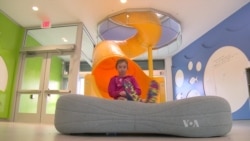Zero is not a good score on a test at school. But Discovery Elementary School is proud of its zero score.
The zero stands for the amount of energy the school uses from traditional power sources. Instead, its energy is provided by on-site renewable sources. Discovery Elementary is the first so-called "net zero" school in Virginia and the largest in the mid-Atlantic region.
The innovative features in the building turn the school into a teaching tool or an open laboratory, where kids can't help but learn about science and sustainability.
In the cafeteria, kids use a scale to determine how much food waste is being created. The school has a built-in solar calendar, to help students tell time and mark changing seasons.
Discovering Discovery
Discovery's instructional technology coordinator, Greg Rusk, pointed to the 1,700 solar panels on the building's roof, which generate the energy needed to run the school.
"That energy is converted to alternating current, which is put back into the grid and we draw out when we need to use energy," he explained, adding that the goal was always to be net-zero, and produce as much electricity as was used. "However, the architects have said that they designed it to be a net-positive so that we'll actually be generating more electricity, hopefully."
More than a third of the walls are glass, to maximize the use of daylight, and solar tubes in the ceiling funnel light into the building's core area. Highly efficient LEDs illuminate places the sun can't reach.
The ceiling has sound-absorbing panels to cut down on noise pollution.
"It's a very open building that generates a lot of sound deflection," Rusk said. "So the panels are in place in the ceiling to absorb some of that sound, to keep the students focused on learning."
Every classroom has uniquely shaped desks and tables and different styles of seating, from traditional seats to chairs that wobble or bounce.
"It's really a kind of students' choice or teachers' choice for what seating students use,” Rusk said. “I think that sort of customization encourages teachers and students to personalize their learning space."
Perhaps the most non-traditional aspect of the non-traditional design, Rusk says, is a slide that kids can use to zip downstairs.
"It's a very orderly line up process and students enjoy sort of talking about that outside of the school,” he said. “It's sort of a key signature piece of the school itself."
Building curriculum on a building
But it's not just about saving energy — there's also an educational philosophy behind the building design.
"This kind of open building encourages them to work together," Rusk said. "Even if you took out all of the technology, just having them working together is the key to any global success. I think we have to keep pursuing that as an educational objective."
Discovery principal Erin Russo agrees.
"It's not just a school building that students go to every day; it's a building that they learn from every day," she said. "Every corner, every hallway is a learning opportunity. For example, our fifth graders did research on one sustainable aspect of this building and, I'm sure if you ask them, that's been the highlight of their learning this year."
Ten-year-old Anna Sprinker investigated the geothermal wells under the playground, which capture energy from beneath the Earth's crust.
"I learned where they were, how deep they were, how they helped net-zero energy, how they played a part in the environment," Anna said. "If you're reading in the science book, you have pictures that are examples, but also it's cool to see them in real life."
It is those examples that teachers say make Discovery Elementary itself a part of the lesson plan.
"We're just beginning to learn about the building and incorporate how that can enhance students' learning," Russo said. "We always do say we are a work in progress."







